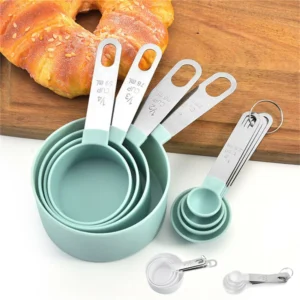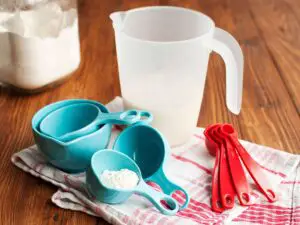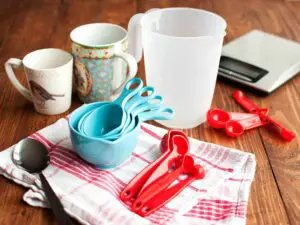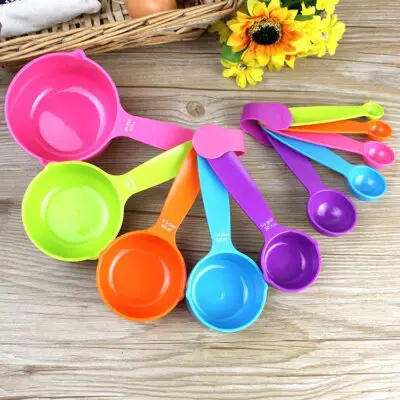Are you tired of guessing and eyeballing your ingredients for baking? Say goodbye to sticky messes and hello to precision and accuracy with measuring cups. Whether you’re a seasoned baker or just starting out, investing in a set of measuring cups for baking is a must-have for any kitchen.
Measuring cups for baking are the artist’s brushes, ensuring that every ingredient is measured accurately and consistently. Whether you’re baking a cake, cookies, or bread, the right set of measuring cups will make all the difference in the taste and texture of your baked goods.
From liquid to dry ingredients, these cups are designed to make your baking experience seamless and stress-free.
What are measuring cups and why are they important in baking?

Measuring cups are essential tools in baking that are used to measure ingredients accurately. They come in a variety of shapes and sizes, but the most common are either liquid or dry measuring cups.
So, liquid measuring cups usually have a spout and a handle and come in capacities ranging from 1 to 4 cups. Dry measuring cups, on the other hand, are typically a set of stacked cups in various sizes that are used to measure ingredients such as flour, sugar, or baking powder.
The importance of measuring cups in baking cannot be overstated. Baking is a science and requires precise measurements of ingredients to ensure that the baked goods turn out as intended.
Measuring cups make it easier to measure ingredients accurately and consistently, which is crucial in ensuring that baked goods turn out well. For example, if a recipe calls for 2 cups of flour, but you measure it out by scooping it into the cup with a spoon, you may end up with more or less flour than the recipe requires. This could lead to a dense and heavy cake or a flat and dry cookie.
In additiona, measuring cups also help to eliminate the guesswork in baking. When you have the right set of measuring cups, you can easily measure out ingredients and avoid making mistakes that could ruin your baked goods. Additionally, using measuring cups also helps you to be more efficient in the kitchen, as you can quickly measure out ingredients without having to weigh them on a scale.
The different types of measuring cups used in baking
There are two main types of measuring cups used in baking: liquid measuring cups and dry measuring cups. Let’s take a closer look at each of them:
- Liquid Measuring Cups – These cups are designed to measure liquids such as milk, oil, or water. They usually have a spout and a handle and come in capacities ranging from 1 to 4 cups. They are made of materials such as glass or plastic and have measurements marked on the side of the cup in milliliters, ounces, or cups. When using a liquid measuring cup, it’s important to measure liquids at eye level to ensure that the measurement is accurate.
- Dry Measuring Cups – These cups are used to measure dry ingredients such as sugar, flour, or baking powder. They are typically a set of stacked cups in various sizes, ranging from 1/4 cup to 1 cup. Dry measuring cups are usually made of stainless steel or plastic and have straight edges that allow you to level off the ingredient by running a straight-edged spatula or knife across the top. It’s important to fill the dry measuring cup to the top and level it off to ensure an accurate measurement.
How to choose the right measuring cup for baking
When it comes to baking, having the right measuring tools can make all the difference in the outcome of your baked goods. When choosing a measuring cup, there are a few key things to consider:
- Material: Measuring cups can be made from plastic, glass, or metal. Plastic is lightweight and affordable, but it can retain odors and stains over time. Glass is sturdy but can be heavy and may break if dropped. Metal measuring cups are durable but can react with acidic ingredients.
- Capacity: Measuring cups come in different sizes, with the most common capacities being 1 cup, 1/2 cup, and 1/4 cup. Make sure to choose a set that includes the sizes you’ll use most often in your baking.
- Graduations: The graduations on the side of the measuring cup indicate the amount of liquid or dry ingredients inside. Make sure that the markings are clear and easy to read, so you can accurately measure your ingredients.
- Ease of use: Some measuring cups have a pouring spout, which can be helpful when pouring liquids into narrow containers. Others have a handle that makes it easier to grip the cup while measuring. Consider which features will make measuring easier for you.
- Accuracy: Measuring cups are generally marked with both standard and metric measurements. Check the accuracy of the markings before using a measuring cup, and make sure that they match with other tools you use in the kitchen.
In summary, when choosing a measuring cup for baking, consider the material, capacity, graduations, ease of use, and accuracy. A good set of measuring cups should be durable, have clear markings, and be easy to use.
The accuracy of measuring cups in baking
Accuracy is crucial in baking, as even small deviations in measurements can result in a difference in the final outcome of your baked goods. Measuring cups are a common tool used in baking to ensure accurate ingredient measurements.
However, it’s important to understand that not all measuring cups are equally accurate. Here are a few factors that can impact the accuracy of measuring cups:
- Calibration: Measuring cups should be calibrated regularly to ensure that they are giving the correct measurements. If you have a plastic measuring cup, you can calibrate it by filling it with water and comparing it to the markings. If the markings are incorrect, make a note of the difference and adjust your measurements accordingly.
- Type of measuring cup: Different types of measuring cups have different levels of accuracy. For example, a glass measuring cup is typically more accurate than a plastic one, as glass is less likely to deform and retain its shape over time.
- Type of ingredient: Some ingredients are more difficult to measure accurately than others. For example, measuring dry ingredients like flour can be tricky, as they tend to pack down and form clumps in the measuring cup. To get an accurate measurement of dry ingredients, it’s best to use a scale rather than a measuring cup.
- User error: The accuracy of measuring cups can also be impacted by user error. For example, if you scoop the ingredients into the cup rather than leveling it off, you may end up with an inaccurate measurement. It’s important to follow proper measuring techniques to ensure accuracy.
The importance of using measuring cups in baking recipes
Measuring cups are an essential tool in baking recipes because they provide a consistent and accurate way to measure ingredients. Baking is a science, and precision is key to ensuring that your baked goods turn out as expected.
Here’s why using measuring cups is so important in baking:
- Consistency: Measuring cups ensure that you use the same amount of ingredients every time you make a recipe. This helps ensure that your baked goods have consistent texture, flavor, and appearance from one batch to the next.
- Precision: Measuring cups give you a precise measurement of each ingredient, which is essential for the success of many baking recipes. If you don’t use enough of one ingredient or use too much of another, it can completely change the outcome of the recipe.
- Standardization: Measuring cups are standardized units of measurement, which helps ensure that your recipes turn out the same regardless of who makes them. Without standardization, it would be difficult to compare and replicate recipes, especially when sharing them with others.
- Ease of use: Measuring cups are easy to use, and most come with measurements marked on the side, so you don’t need to use a separate measuring tool. This saves time and reduces the risk of making mistakes when measuring ingredients.
The conversion between cups and other units of measurement in baking
In baking, converting between units of measurement, such as cups and milliliters or ounces, is important to ensure that recipes turn out correctly. Here are some common conversions:
1 cup = 236.59 mL 1 cup = 8 fluid ounces 1 tablespoon = 15 mL 1 teaspoon = 5 mL
Here are some common conversions between cups and other units of measurement:
- 1/4 cup = 59 mL
- 1/3 cup = 79 mL
- 1/2 cup = 118 mL
- 2/3 cup = 158 mL
- 3/4 cup = 177 mL
It’s also important to note that these conversions may not be exact due to variations in measurements and the intended level of precision for a specific recipe. In baking, it’s always best to use a kitchen scale for accurate measurements.
How to measure dry ingredients using measuring cups
Measuring dry ingredients using measuring cups is a common method in baking, but it can be tricky to get accurate results. Here’s a simple method to ensure accurate measurements:
- Fluff up the ingredient: Before measuring, fluff up the ingredient with a spoon or fork to loosen them and remove any clumps.
- Spoon and level: Spoon the ingredient into the measuring cup until it’s overflowing, then use a straight edge (such as a knife) to level off the excess by sweeping it across the top of the measuring cup.
- Don’t tap the cup: Tapping the measuring cup on the counter can cause the ingredients to settle and result in too much or too little of the ingredients in the cup.
- Use proper measuring cups: Make sure to use the correct size measuring cup for the ingredient you’re measuring. For example, a tablespoon measuring cup is used for measuring small amounts of ingredients, while a 1-cup measuring cup is used for larger amounts.
It’s important to measure ingredients accurately in baking, as even small variations in measurement can have a significant impact on the final product. If a recipe calls for a specific volume or weight of an ingredient, it’s best to use a kitchen scale to ensure accuracy.
How to measure liquid ingredients using measuring cups

Measuring liquid ingredients using measuring cups is a straightforward process. Here’s how you can do it:
- Choose the right measuring cup: There are different types of measuring cups for liquids, such as glass or plastic measuring cups with a spout or measuring cups with measurement markings on the side. Make sure to choose the appropriate cup for the ingredient you are measuring.
- Place the measuring cup on a level surface: Make sure the cup is on a flat, stable surface to ensure accurate measurements.
- Pour the liquid into the measuring cup: Start pouring the liquid into the measuring cup slowly and steadily, without splashing.
- Check the measurement at eye level: For more accurate measurements, hold the cup up to eye level and look at the measurement markings from the side. If the liquid is below the desired marking, add more. If it is above the desired marking, remove some.
- Pour the liquid into your recipe: Once you have the right amount of liquid, carefully pour it into your mixing bowl or recipe.
It is important to be precise when measuring liquids, as even a small error in measurement can have a significant impact on the outcome of your recipe.
The role of measuring cups in portion control and ingredient ratios
Measuring cups play a crucial role in portion control and ingredient ratios in cooking and baking. Precise measurements ensure that the ingredients in a recipe are in the correct proportion, which can impact the texture, taste, and overall success of a dish.
Portion control is also an important aspect of cooking and baking, and measuring cups help to ensure that you are using the correct amount of each ingredient. This is especially important when following a recipe, as using too much or too little of an ingredient can significantly alter the flavor and texture of the dish.
In baking, precise measurements are particularly important, as ingredients such as flour, sugar, and baking powder interact with each other in a specific way to create the desired end result. Measuring cups help to ensure that these ingredients are in the correct ratios, which is essential for achieving the desired texture and taste in baked goods.
Overall, measuring cups play an important role in portion control and ingredient ratios, helping to ensure that recipes turn out consistently and correctly every time.
How to properly store measuring cups
Proper storage of measuring cups is important to ensure their longevity and accuracy. Here are some tips for storing measuring cups:
- Keep them dry: Wipe any moisture from the surface of the measuring cups before storing them. This helps to prevent rust and other forms of corrosion.
- Store them in a dry place: Avoid storing measuring cups in damp areas, such as the bottom of a cupboard near a sink. A dry pantry or kitchen cabinet is a better option.
- Store them separately: If you have multiple measuring cups, store each cup individually rather than stacking them on top of each other. This helps to prevent damage to the measurement markings.
- Store them upright: Store measuring cups upright, with the measurement markings facing out, to make it easier to read them when you need to use them.
- Avoid overcrowding: Avoid overcrowding your kitchen drawers or cabinets, as this can make it difficult to access your measuring cups and can cause damage to the cups or their measurement markings.
By following these tips, you can help to ensure that your measuring cups stay accurate and in good condition for years to come.
The impact of temperature on measuring cups in baking
Temperature can have an impact on measuring cups in baking, especially when measuring ingredients that are sensitive to temperature changes, such as liquids and fats. Here’s how temperature can affect measuring cups in baking:
- Expansion and contraction of liquids: Some liquids, such as oil or honey, expand or contract when exposed to changes in temperature. For example, if you measure a liquid when it is warm and then use it in a recipe when it has cooled, the volume of the liquid will have changed, which can impact the ratios of ingredients in the recipe.
- Expansion of solids: Some solid ingredients, such as chocolate, can also expand when exposed to changes in temperature. For example, if you measure solid chocolate and then melt it, the volume of the chocolate will change, which can impact the ratios of ingredients in the recipe.
- Shrinking or expansion of measuring cups: In some cases, measuring cups themselves can expand or contract in response to changes in temperature, which can impact the accuracy of their measurement markings.
To minimize the impact of temperature on measuring cups in baking, it is recommended to measure ingredients at room temperature and to avoid exposing them to extreme temperature changes.
Additionally, using glass or metal measuring cups, which are less likely to be affected by temperature changes, can help to ensure accurate measurements.
The use of technology in measuring cups for baking
Technology has made its way into the world of measuring cups for baking, offering new and innovative ways to measure ingredients. Here are some examples of how technology is being used in measuring cups:
- Digital measuring cups: Digital measuring cups use electronic sensors to accurately measure liquids and solids. Some digital measuring cups even come equipped with an LCD display that shows the exact volume of the ingredient being measured.
- Smart measuring cups: Smart measuring cups are equipped with Bluetooth or Wi-Fi technology, allowing them to connect to a smartphone app. This allows for more precise measurements and allows the user to save and access recipes, conversion charts, and other useful information.
- Scale-based measuring cups: Scale-based measuring cups use digital weighing technology to measure ingredients by weight rather than volume. This is especially useful for baking, as ingredients can be measured more accurately and consistently.
- Multi-functional measuring cups: Some multi-functional measuring cups come equipped with multiple measurement options, such as volume, weight, and temperature. This allows for more accurate and versatile measurements, especially for baking, where precise measurements are essential.
Overall, the use of technology in measuring cups has made it easier and more convenient to measure ingredients in baking. These innovations provide bakers with more accurate and precise measurements, helping to ensure that recipes turn out consistently and correctly every time.
The importance of proper measuring cup usage in baking for consistent results

Proper usage of measuring cups is crucial for achieving consistent results in baking. Incorrect measurement of ingredients can have a significant impact on the taste, texture, and overall success of a baked good. Here’s why proper measuring cup usage is important:
- Consistent ingredient ratios: In baking, precise measurements are essential to ensure that ingredients are in the correct ratio. Measuring cups help to ensure that ingredients are measured accurately, which is crucial for achieving the desired end result.
- Precise recipes: Many baked goods require precise measurements of ingredients in order to turn out correctly. Incorrect measurements can lead to recipes that are too dry, too sweet or have a different texture than intended.
- Reproducibility: Proper measuring cup usage is important for ensuring that recipes can be repeated and reproduced consistently. By measuring ingredients accurately each time, you can achieve the same results every time you make a recipe.
- Better results: Proper measuring cup usage leads to better results in baking. Precise measurements help to ensure that recipes turn out correctly, with the desired texture, flavor, and appearance.
The role of measuring cups in baking for special diets and restrictions
Measuring cups play an important role in baking for those with special diets and restrictions, such as gluten-free, vegan, or low-sugar diets. Here’s how measuring cups can help:
- Precise measurements: Measuring cups help to ensure that ingredients are measured accurately, which is crucial for recipes that need to meet specific dietary restrictions. For example, gluten-free baking requires precise measurements of gluten-free flour to ensure that the recipe turns out correctly.
- Consistent ingredient ratios: Proper measuring cup usage helps to ensure that ingredients are in the correct ratio, which is important for recipes that follow special diets and restrictions. For example, low-sugar recipes require precise measurements of sugar to ensure that the end result is not too sweet.
- Recipe modifications: Measuring cups can be used to modify recipes to meet special dietary restrictions. For example, by measuring out a specific amount of a sugar substitute, you can make a recipe that is suitable for those following a low-sugar diet.
- Following recipes: Following recipes that meet special dietary restrictions often requires precise measurements of ingredients. Measuring cups help to ensure that these recipes turn out correctly every time.
Recommended:
- How much does a 5 gallon bucket of paint weigh?
- Largest luggage size for check-in
- How much is a keg of bud light?
- How much does a 2x4x8 weigh?
The use of measuring cups in professional and home baking
Measuring cups are a common tool used in both professional and home baking. Here’s how they are used in each set:
- Professional Baking: In professional kitchens and bakeries, measuring cups are an essential tool for achieving consistent and accurate results. Bakers use measuring cups to measure ingredients precisely, ensuring that recipes turn out correctly and consistently. In commercial kitchens, measuring cups may also be used to measure large quantities of ingredients for bulk baking.
- Home Baking: In home kitchens, measuring cups are a common tool used for baking. Home bakers use measuring cups to measure ingredients for recipes, helping to ensure that their baked goods turn out correctly. Many home bakers appreciate the convenience and ease of use that were measuring cups offer, as well as the ability to measure ingredients accurately and consistently.
In both professional and home baking, measuring cups play a crucial role in ensuring accurate and consistent measurements of ingredients. Whether you’re a professional baker or a home cook, measuring cups are a valuable tool that can help you achieve the best results in your baking.
Conclusion
If you are a baker, then you must know the importance of measuring cups for baking. Here on this page, we have all the information on measuring cups, from the sizes and types to how you should use them for the best result. We have got you covered on this page.


